Sewer and septic systems are EVERYWHERE around us, yet one of the questions I am asked most often is – how do they work?
Being in the business of water distribution and bringing wastewater from one place to another requires me to have a fairly good understanding about how sewer and septic systems work.
But I am constantly surprised about how little the common person understands the function of each system because these systems are in use every single day. Without them, we would literally be swimming in basins of wastewater no matter where we went.
Trust me, I get it – it’s not the most glamorous subject, but wastewater treatment and distribution is essential to our everyday life – and if you ever plan on buying either a home or business, you should have a working knowledge of how these systems work too. So let’s dive in!
Original article: https://home.howstuffworks.com/home-improvement/plumbing/sewer.htm
Why Do We Need a Sewer System?
Each time you flush the toilet or you wash something down the sink’s drain, you create sewage (also known in polite society as wastewater). One question that many people might ask is, “Why not simply dump this wastewater onto the ground outside the house, or into a nearby stream?” There are three main things about wastewater that make it something you don’t want to release into the environment:
- It stinks. If you release wastewater directly into the environment, things get very smelly very fast.
- It contains harmful bacteria. Human waste naturally contains coliform bacteria (for example, E. coli) and other bacteria that can cause disease. Once water becomes infected with these bacteria, it becomes a health hazard.
- It contains suspended solids and chemicals that affect the environment. For example:
- Wastewater contains nitrogen and phosphates that, being fertilizers, encourage the growth of algae. Excessive algae growth can block sunlight and foul the water.
- Wastewater contains organic material that bacteria in the environment will start decomposing. When they do, these bacteria consume oxygen in the water. The resulting lack of oxygen kills fish.
- The suspended solids in wastewater make the water look murky and can affect the ability of many fish to breathe and see.
- The increased algae, reduced oxygen and murkiness destroy the ability of a stream or lake to support wildlife, and all of the fish, frogs and other life forms quickly die.
No one wants to live in an place that stinks, is full of deadly bacteria and cannot support aquatic life. That’s why communities build wastewater treatment plants and enforce laws against the release of raw sewage into the environment.
Private Treatment: The Septic Tank
In rural areas where houses are spaced so far apart that a sewer system would be too expensive to install, people install their own, private sewage treatment plants. These are called septic tanks.
A septic tank is simply a big concrete or steel tank that is buried in the yard. The tank might hold 1,000 gallons (4,000 liters) of water. Wastewater flows into the tank at one end and leaves the tank at the other. The tank looks something like this in cross-section:
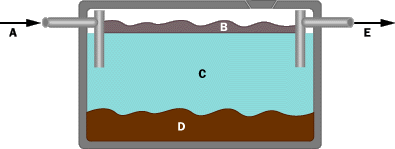

In this picture, you can see three layers. Anything that floats rises to the top and forms a layer known as the scum layer. Anything heavier than water sinks to form the sludge layer. In the middle is a fairly clear water layer. This body of water contains bacteria and chemicals like nitrogen and phosphorous that act as fertilizers, but it is largely free of solids.
Wastewater comes into the septic tank from the sewer pipes in the house, as shown here:
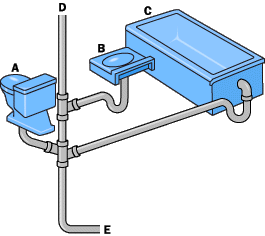

A septic tank naturally produces gases (caused by bacteria breaking down the organic material in the wastewater), and these gases don’t smell good. Sinks therefore have loops of pipe called P-traps that hold water in the lower loop and block the gases from flowing back into the house. The gases flow up a vent pipe instead — if you look at the roof of any house, you will see one or more vent pipes poking through.
As new water enters the tank, it displaces the water that’s already there. This water flows out of the septic tank and into a drain field. A drain field is made of perforated pipes buried in trenches filled with gravel. The following diagram shows an overhead view of a house, septic tank, distribution box and drain field:
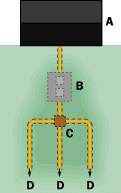

A typical drain field pipe is 4 inches (10 centimeters) in diameter and is buried in a trench that is 4 to 6 feet (about 1.5 m) deep and 2 feet (0.6 m) wide. The gravel fills the bottom 2 to 3 feet of the trench and dirt covers the gravel, like this:

The water is slowly absorbed and filtered by the ground in the drain field. The size of the drain field is determined by how well the ground absorbs water. In places where the ground is hard clay that absorbs water very slowly, the drain field has to be much bigger.
A septic system is normally powered by nothing but gravity. Water flows down from the house to the tank, and down from the tank to the drain field. It is a completely passive system.
You may have heard the expression, “The grass is always greener over the septic tank.” Actually, it’s the drain field, and the grass really is greener — it takes advantage of the moisture and nutrients in the drain field.
Urban Wastewater Systems
In urban and suburban areas where people are packed closer together and where there is a lot more wastewater to treat, the community will construct a sewer system that collects wastewater and takes it to a wastewater treatment facility.
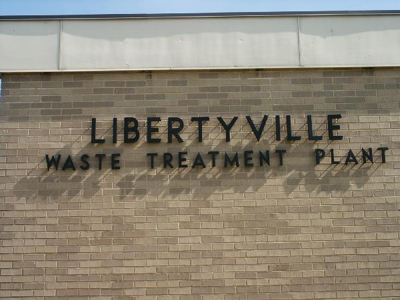
In the ideal case, a sewer system is completely gravity-powered, like a septic system. Pipes from each house or building flow to a sewer main that runs, for example, down the middle of the street. The sewer main might be 3 to 5 feet (1 to 1.5 m) in diameter. Periodically, a vertical pipe will run up from the main to the surface, where it is covered by a manhole cover. Manholes allow access to the main for maintenance purposes.
The sewer mains flow into progressively larger pipes until they reach the wastewater treatment plant. In order to help gravity do its job, the wastewater treatment plant is usually located in a low-lying area, and sewer mains will often follow creekbeds and streambeds (which flow naturally downhill) to the plant.
Normally, the lay of the land will not completely cooperate, and gravity cannot do all the work. In these cases, the sewer system will include a grinder-pump or a lift station to move the wastewater up over a hill.
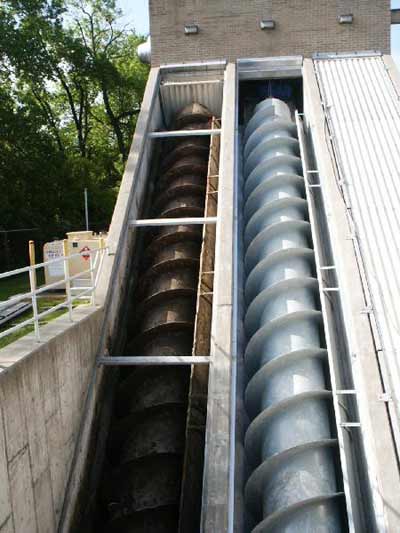
Once the water reaches the wastewater treatment plant, it goes through one, two or three stages of treatment (depending on the sophistication of the plant).
Here’s what each stage does:
- The first stage, known as primary treatment, does the same thing a septic tank does. It allows the solids to settle out of the water and the scum to rise. The system then collects the solids for disposal (either in a landfill or an incinerator).
Primary treatment is very simple — it involves a screen followed by a set of pools or ponds that let the water sit so that the solids can settle out.

- Primary treatment might remove half of the solids, organic materials and bacteria from the water. If the plant does no more than primary treatment, then the water is chlorinated to kill the remaining bacteria and discharged.
- The second stage, known as secondary treatment, removes organic materials and nutrients. This is done with the help of bacteria — the water flows to large, aerated tanks where bacteria consume everything they can.

- The wastewater then flows to settling tanks where the bacteria settle out. Secondary treatment might remove 90 percent of all solids and organic materials from the wastewater.
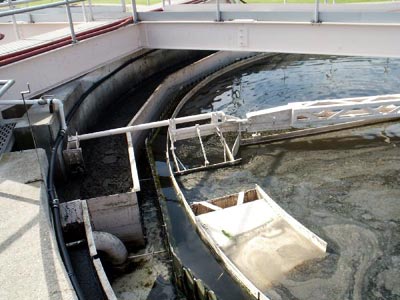
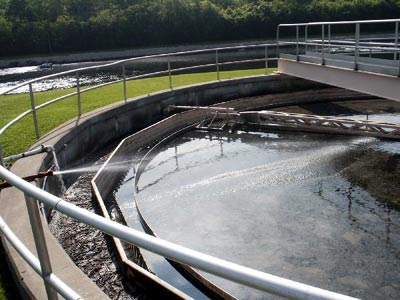
- he third stage, known as tertiary treatment, varies depending on the community and the composition of the wastewater. Typically, the third stage will use chemicals to remove phosphorous and nitrogen from the water, but may also include filter beds and other types of treatment. Chlorine added to the water kills any remaining bacteria, and the water is discharged.
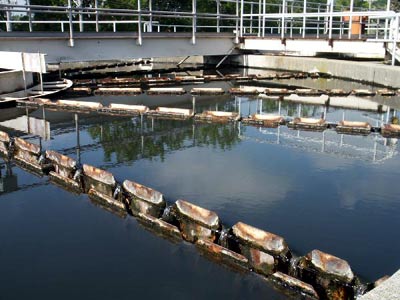
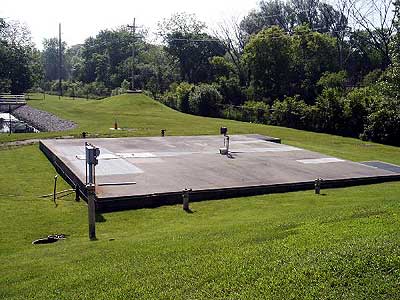
Measuring the Effectiveness of a Treatment Plant
The effectiveness of wastewater treatment plants is measured on several different scales. Here are some of the most common:
- pH – This is the measure of the water’s acidity once it leaves the plant. Ideally, the water’s pH would match the pH of the river or lake that receives the plant’s output.
- BOD (bio-chemical oxygen demand) – BOD is a measure of how much oxygen in the water will be required to finish digesting the organic material left in the effluent. Ideally, the BOD would be zero.
- Dissolved oxygen – This is the amount of oxygen in the water as it leaves the plant. If the water contains no oxygen, it will kill any aquatic life that comes into contact with it. Dissolved oxygen should be as high as possible and needs to cover the BOD.
- Suspended solids – This is the measure of the solids remaining in the water after treatment. Ideally, suspended solids would be zero.
- Total phosphorous and nitrogen – This is the measure of the nutrients remaining in the water.
- Chlorine – The chlorine used to kill harmful bacteria needs to be removed so it does not kill beneficial bacteria in the environment. Ideally, chlorine should not be detectable.
- Coliform bacteria count – This is the measure of fecal bacteria remaining in the water. Ideally, this number would be zero. Note that water in the environment is not totally free of fecal bacteria — birds and other wildlife do introduce some.
The main reason why these indicators need to be watched so closely is because any community produces a huge quantity of wastewater. Discharge levels ranging from 10 million to 100 million gallons per day (38 million to 380 million liters) are common for a wastewater treatment plant.
Be Safe – Think Ahead
At PPS, we value preparation, trust, and integrity with our clients. We provide systems and solutions, not price only products. Though we do not claim to have every solution for every disaster, we encourage clients to be open about their solutions and include all possible vendors. When in a disaster situation, a city, county, state, or government needs to consider all options.
As such, we guide our clients to prepare in advance for the worst, be it earthquake, flood, fires, or just an aging infrastructure.
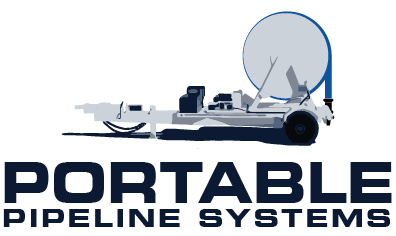


 Sales Office Location
Sales Office Location
 sales@portablepipelinesystem.com
sales@portablepipelinesystem.com